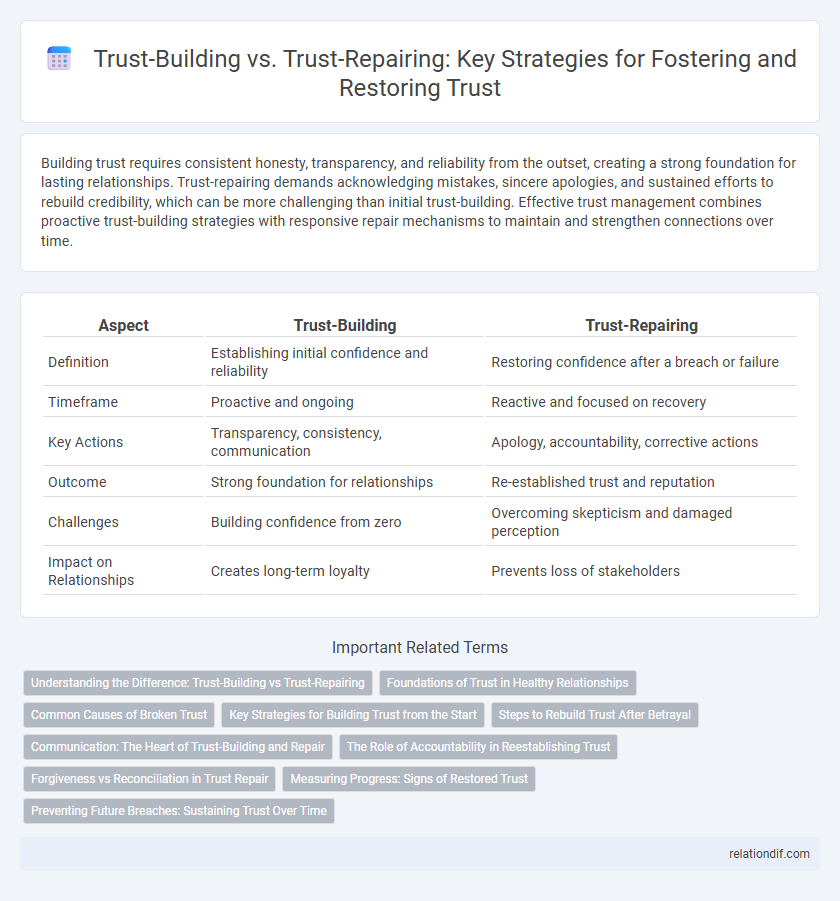Building trust requires consistent honesty, transparency, and reliability from the outset, creating a strong foundation for lasting relationships. Trust-repairing demands acknowledging mistakes, sincere apologies, and sustained efforts to rebuild credibility, which can be more challenging than initial trust-building. Effective trust management combines proactive trust-building strategies with responsive repair mechanisms to maintain and strengthen connections over time.
Table of Comparison
| Aspect | Trust-Building | Trust-Repairing |
|---|---|---|
| Definition | Establishing initial confidence and reliability | Restoring confidence after a breach or failure |
| Timeframe | Proactive and ongoing | Reactive and focused on recovery |
| Key Actions | Transparency, consistency, communication | Apology, accountability, corrective actions |
| Outcome | Strong foundation for relationships | Re-established trust and reputation |
| Challenges | Building confidence from zero | Overcoming skepticism and damaged perception |
| Impact on Relationships | Creates long-term loyalty | Prevents loss of stakeholders |
Understanding the Difference: Trust-Building vs Trust-Repairing
Trust-building establishes a stable foundation through consistent actions, transparency, and reliability, fostering long-term confidence. Trust-repairing requires acknowledging breaches, taking accountability, and demonstrating sincere efforts to rebuild credibility over time. Differentiating these processes highlights that proactive trust-building prevents conflicts, whereas trust-repairing is reactive and more complex due to damaged perceptions.
Foundations of Trust in Healthy Relationships
Foundations of trust in healthy relationships rely on consistent honesty, transparency, and reliable actions that demonstrate commitment over time. Trust-building involves proactive communication and mutual respect, creating a stable environment where vulnerability is safe. When trust is broken, repairing requires acknowledgment of mistakes, sincere apologies, and consistent efforts to reestablish reliability and emotional safety.
Common Causes of Broken Trust
Common causes of broken trust include betrayal, dishonesty, and lack of communication, which significantly damage relationships. Trust-building requires consistent transparency, accountability, and empathy to create a strong foundation. Trust-repairing demands sincere apologies, demonstrated changes in behavior, and rebuilding credibility over time.
Key Strategies for Building Trust from the Start
Establishing transparent communication and consistent actions are key strategies for building trust from the start, fostering credibility and reliability in relationships. Demonstrating empathy and active listening enhances emotional connection, creating a foundation of mutual respect and understanding. Implementing accountability measures and delivering on promises reinforce trustworthiness, preventing breaches that require later repair.
Steps to Rebuild Trust After Betrayal
Rebuilding trust after betrayal requires consistent transparency, open communication, and demonstrated accountability over time. Establishing clear boundaries and actively listening to the betrayed party's concerns fosters emotional safety and gradual forgiveness. Prioritizing actions that align with promises and showing genuine remorse are essential to restore credibility and strengthen the relationship's foundation.
Communication: The Heart of Trust-Building and Repair
Effective communication serves as the foundation for both trust-building and trust-repairing, enabling clarity, transparency, and emotional connection between parties. Consistent, honest dialogue fosters confidence before breaches occur, while empathetic listening and timely, accountable responses are critical in rebuilding damaged trust. Mastering communication strategies reduces misunderstandings and cultivates long-term relational resilience.
The Role of Accountability in Reestablishing Trust
Accountability serves as a critical mechanism in trust-building by fostering transparency, responsibility, and consistent follow-through on commitments. In trust-repairing, acknowledging mistakes and implementing corrective actions demonstrate genuine accountability, which is essential to restore credibility and rebuild relationships. Organizations that prioritize accountable behavior reduce uncertainty and facilitate sustained trust over time.
Forgiveness vs Reconciliation in Trust Repair
Trust repair involves distinct processes of forgiveness and reconciliation, where forgiveness focuses on releasing resentment towards the transgressor, while reconciliation entails rebuilding the relationship through mutual understanding and renewed commitment. Forgiveness can occur internally without direct interaction, emphasizing personal healing, whereas reconciliation requires active communication and collaborative efforts to restore trust. Effective trust repair combines both elements, balancing emotional forgiveness with practical steps toward re-establishing relational harmony and confidence.
Measuring Progress: Signs of Restored Trust
Measuring progress in trust-building involves consistent transparency, reliable communication, and demonstrated accountability, which indicate a solid foundation of trust. In trust-repairing, observable behaviors such as increased openness, acknowledgment of past mistakes, and sustained effort to meet commitments signal restored confidence. Regular feedback and emotional reassurance also serve as key metrics for assessing the revival of trust in relationships or organizations.
Preventing Future Breaches: Sustaining Trust Over Time
Proactively building trust through consistent transparency and accountability reduces the risk of future breaches and fosters long-term loyalty. Trust repair demands targeted actions like sincere apologies and measurable changes, but prevention minimizes the need for costly recovery efforts. Sustaining trust over time relies on continuous communication and ethical behavior, which collectively strengthen organizational credibility.
Trust-building vs trust-repairing Infographic

 relationdif.com
relationdif.com